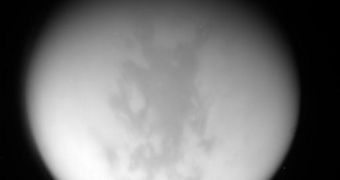Scientists operating the NASA Cassini spacecraft announced recently the conclusions of a new flight the space probe took around Saturn's largest and most interesting moon, Titan. The scientific instrument has been orbiting the gas giant, collecting data about its surface, rings and moons, for about six years. It achieved orbital insertion around Saturn on July 1, 2004, and its mission is scheduled to continue until at least 2017. In the mean time, astronomers continue to use its observation powers to snap incredible pictures of Titan and Enceladus, two Saturnine moons that captured the attention of the international scientific community, Space reports.
The most recent flyby Cassini did around Titan took place Friday afternoon, June 4 Pacific time, or June 5 UTC. The space probe was maneuvered in such a manner that it came in very close to the surface of the moon. At the point of maximum approach, the orbiter was only 1,300 miles (2,000 kilometers) above Titan's surface. While this may seem like a small distance at first, experts say that other flights have seen the probe coming numerous times closer to its targets without incident.
One of the main goals of the new investigation was the study of Kraken Mare. This liquid hydrocarbon lake covers a surface larger than the Caspian Sea here on Earth. It spans more than 400,000 square kilometers (150,000 square miles), and researchers have always been curious to learn more about it. They suspect that most lakes on Titan are filled with various mixes of carbon and hydrogen atoms, such as for example methane and ethane. More recent studies of the planet have revealed that the concentration of lakes, currently higher at the North Pole, shifts with Titan's seasons. Admittedly, these last far more than they do back on Earth.
This was the 70th flyby Cassini did of Enceladus. The new mission was called T69, but that discrepancy is caused by some engine firing which took place early on in the mission. The purpose was orbital adjustment and correction. The new images of Kraken Mare were captured using the visual and infrared spectrometer instruments, but the resolution is not amazing. The moon is covered with a very thick atmosphere, which prevents tools such as this to make their way to the surface. The imaging science subsystem cameras were also involved in the new observations, say experts at the NASA Jet Propulsion Laboratory (JPL), in Pasadena, California, which manage Cassini.

 14 DAY TRIAL //
14 DAY TRIAL //